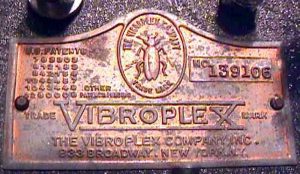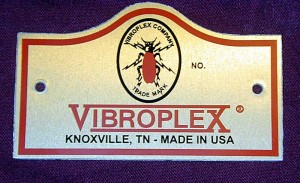
Friday, Aug. 25, 2017 — While browsing the listings for code keys, I saw one for a Vibroplex World War II Lightning Bug DeLuxe with the “battleship grey” base. The key looked fine but it was the nameplate that caught my attention.
The key — circa 1945 — had what I thought was serial number near the middle of the range of keys believed to have been manufactured that year. The serial number was embossed, rather than the usual stamped numbers as had been used on the Vibroplex brass nameplate since it was introduced about 1920.
 I’ve never given much thought to the exact (near exact?) date when Vibroplex moved from stamped serial numbers to embossed ones. I always associated embossed s/n with keys manufactured after 1945.
I’ve never given much thought to the exact (near exact?) date when Vibroplex moved from stamped serial numbers to embossed ones. I always associated embossed s/n with keys manufactured after 1945.
Maybe I’m getting down in the weeds of Vibroplex history, but surely I’m not the only one who pays attention to the difference between the nameplate serial number styles.
Apparently, Vibroplex made the change sometime in 1945; I thought it was actually 1946 and after, but a quick look on the web (and the Lightning Bug WWII Deluxe on eBay) shows the change was introduced in 1945 — well before I originally believed it was.
In fact, after going to check N0UF’s great Vibroplex name plate guide I noticed the name plate he showed as an example of the D5 nameplate (1942-1945) has embossed serial numbers rather than stamped. The plate’s serial number (139,106) dates it to early 1945 or so, and the plate is painted tin rather than brass. The Lightning Bug WWII DeLuxe I saw with the embossed serial number was 142,554.
Looking at N0UF’s Vibroplex nameplate guide, it looks like Vibroplex used embossed serials for the last part of the D5 and most or all of the D6 nameplates — 1945 through 1962. What I can’t be certain of is if the company used embossed serial numbers all through those years (I’ll have to check my collection to help determine if that’s a faulty assumption … any input, guys?).
 With the introduction of the D7 brass nameplates in 1963, it appears that Vibroplex returned to the practice of stamping the serial numbers from the top of the plates — one that continued until the new Knoxville-style nameplates were introduced.
With the introduction of the D7 brass nameplates in 1963, it appears that Vibroplex returned to the practice of stamping the serial numbers from the top of the plates — one that continued until the new Knoxville-style nameplates were introduced.
WHY THE CHANGE? I haven’t taken time to ask Scott about the change in nameplates, though I have heard from more than one source the supplier quit making them or went out of business and scrapped the dies.
As I have noted before, something funky was going on with the nameplates well before the company was sold and it moved to Knoxville. Just look at any of the nameplates on the 100th Anniversary Originals and check for the finer details on the stamping and then compare those plates to earlier ones. I don’t know what it would have cost to create new dies for stamping nameplates, but it would likely be substantial. Presumably the aluminum plates were the most cost-effective way to go.
-30-
